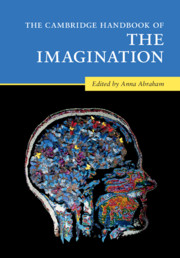Book contents
- The Cambridge Handbook of the Imagination
- The Cambridge Handbook of the Imagination
- Copyright page
- Dedication
- Contents
- Figures
- Contributors
- Acknowledgments
- 1 Surveying the Imagination Landscape
- Part I Theoretical Perspectives on the Imagination
- Part II Imagery-Based Forms of the Imagination
- 12 The Visual Imagination
- 13 Musical Imagery
- 14 Neurophysiological Foundations and Practical Applications of Motor Imagery
- 15 Temporal Mental Imagery
- 16 Emotional Mental Imagery
- 17 Multisensory Perception and Mental Imagery
- 18 Evocation: How Mental Imagery Spans Across the Senses
- Part III Intentionality-Based Forms of the Imagination
- Part IV Novel Combinatorial Forms of the Imagination
- Part V Phenomenology-Based Forms of the Imagination
- Part VI Altered States of the Imagination
- Name Index
- Subject Index
- References
18 - Evocation: How Mental Imagery Spans Across the Senses
from Part II - Imagery-Based Forms of the Imagination
Published online by Cambridge University Press: 26 May 2020
- The Cambridge Handbook of the Imagination
- The Cambridge Handbook of the Imagination
- Copyright page
- Dedication
- Contents
- Figures
- Contributors
- Acknowledgments
- 1 Surveying the Imagination Landscape
- Part I Theoretical Perspectives on the Imagination
- Part II Imagery-Based Forms of the Imagination
- 12 The Visual Imagination
- 13 Musical Imagery
- 14 Neurophysiological Foundations and Practical Applications of Motor Imagery
- 15 Temporal Mental Imagery
- 16 Emotional Mental Imagery
- 17 Multisensory Perception and Mental Imagery
- 18 Evocation: How Mental Imagery Spans Across the Senses
- Part III Intentionality-Based Forms of the Imagination
- Part IV Novel Combinatorial Forms of the Imagination
- Part V Phenomenology-Based Forms of the Imagination
- Part VI Altered States of the Imagination
- Name Index
- Subject Index
- References
Summary
Listening to Wagner’s “Ride of the Valkyries” may lead us to imagine a scene of an army charging ; seeing Margaret Thatcher on a silent TV screen may make us imagine the sound of her voice; seeing a feather moving on the surface of a hand might make us almost feel the stroke on our own hand. All these cases may be accounted for under the category of crossmodal imagery: the occurrence of a conscious mental image in a given sensory modality, caused by the presentation of an object in another modality. This chapter shows why crossmodal imagery should be distinguished from mere neural activation across the senses and internally generated imagery, and restricts its definition to cases in which the mental image in an unstimulated modality is caused by another sensory stimulus, and its contents constrained by this stimulus. This more precise category of crossmodal imagery challenges us to re-examine several accepted claims in the domain of imagination: The induction of mental imagery does not necessarily follow modal paths, daydreaming might not be internally but externally generated by what we hear or feel, and non-visual imagery, which is often considered less frequent, may prove easier to induce crossmodally through visual, rather than through nonvisual stimulus.
Keywords
- Type
- Chapter
- Information
- The Cambridge Handbook of the Imagination , pp. 276 - 290Publisher: Cambridge University PressPrint publication year: 2020
References
- 2
- Cited by

